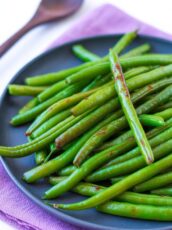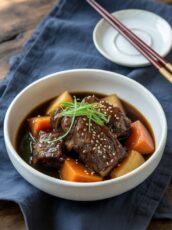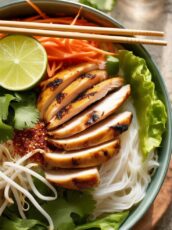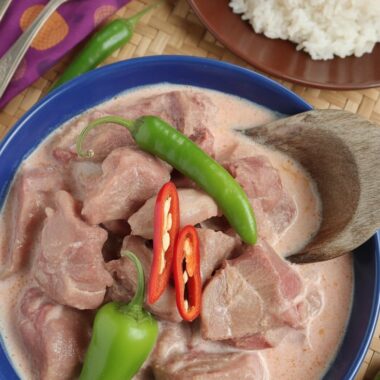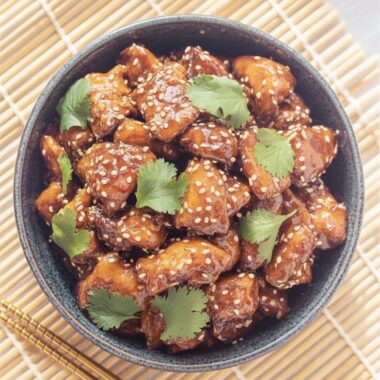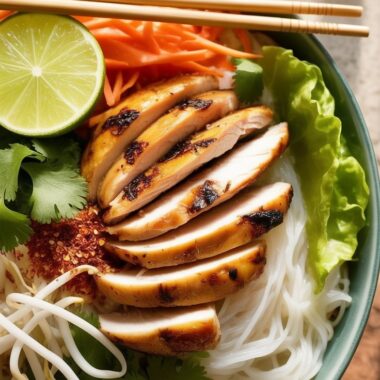There are days when you want something hearty and fiery to wake up your taste buds, and Yukgaejang is exactly that. This spicy beef soup has been on my table during cold winter nights, but I’ve also seen my Korean friends sip on it during the hottest summer days, saying it gives them strength. It’s the kind of recipe that doesn’t just fill your stomach but warms you in a way only slow-simmered soups can.
 What Makes Yukgaejang Special
What Makes Yukgaejang Special
Yukgaejang is one of those soups that feels like it has a story in every spoonful. The beef is shredded after a long simmer, giving it that tender texture that pairs beautifully with earthy fernbrake (gosari) and mushrooms. I remember the first time I tried it at a little restaurant in Seoul — the bowl arrived looking like liquid fire, but the flavor was layered, not just hot. You get savory depth, gentle spice, and just enough richness from the sesame oil.
At home, I’ve learned that Yukgaejang can be a complete meal on its own. Sure, it’s usually served with rice and kimchi, but honestly, a steaming bowl of this soup with a little rice mixed in has carried me through many solo dinners without the need for anything else on the table.
Ingredient Notes and Practical Tips
Beef
Brisket is my go-to, but I’ve used flank steak when brisket was too pricey at the butcher. Both shred beautifully. If you want a lighter version, you can make it with chicken — in that case, it’s called Dakgaejang, and it has a softer, milder profile but is still deeply comforting.
Fernbrake (Gosari)
This is the ingredient that makes people hesitate, since it’s not easy to find outside Korean stores. I buy dried fernbrake when I can — yes, it takes some soaking and boiling, but I usually do a big batch, portion it out, and freeze it. That way, I have some ready whenever I crave Yukgaejang. If you can’t find it, don’t stress too much. Add extra shiitake mushrooms and green onions. The soup will still taste rich and earthy.
Bean Sprouts
I’ve made the mistake of tossing in too many bean sprouts before, thinking “more crunch, more fun.” The truth is, they release water and can dull the depth of the broth. A moderate handful is all you need to balance out the heartiness of the beef.
Chili Oil vs. Chili Powder
Korean chili powder (gochugaru) is non-negotiable — it brings spice and that signature red color. But adding chili oil makes the soup glossy and extra vibrant. If you like that fiery look without the soup tasting grainy, chili oil is the way to go. I usually make a small jar at home with sesame oil and chili flakes, and it keeps well in the fridge.
Optional Add-Ins
Glass noodles are popular, and I’ve tried them, but honestly, they’re best eaten right away since they don’t store well. Beaten eggs, too, can make the broth richer, but I usually skip them because I like keeping the flavors clean and bold.
 Cooking Tips from My Kitchen
Cooking Tips from My Kitchen
Don’t rush the broth. The simmering step is where all the magic happens. I usually put the brisket to simmer while I prep other ingredients or even fold laundry — it’s that kind of hands-off cooking that rewards patience.
Watch the chili powder. Stir it quickly into the oil but don’t let it burn — once, I left it a second too long, and the whole soup carried a bitter note I couldn’t fix.
Shred the beef, don’t chop. Pulling it apart by hand (after it cools a little) gives the soup that signature texture you just can’t get with cubes.
Storing and Reheating
I usually make a big pot of Yukgaejang on a Sunday, and it gets better over the next few days as the flavors deepen. Keep it in the fridge for up to 4 days. If I’m freezing it, I portion it into smaller containers without bean sprouts, then add fresh sprouts when reheating — that way the texture stays crisp.
If you freeze it, thaw in the fridge overnight and reheat gently on the stove. Don’t boil too hard after reheating; just a steady simmer will bring it back to life.
Serving Ideas
Always with a bowl of hot steamed rice. I like spooning a little rice into the soup as I eat, so every bite is balanced.
Kimchi is the classic sidekick, but if I don’t have any, a simple cucumber salad works well.
For guests, I’ll set out small plates of banchan (side dishes), but truthfully, Yukgaejang doesn’t need much else to shine.
 Common Questions I Get
Common Questions I Get
Is it too spicy for kids?
It depends on how much chili powder you add. I’ve made a mild version by cutting the chili powder in half and skipping chili oil, and kids in my family have happily slurped it up.
Can I make it vegetarian?
Yes! Replace the beef broth with a rich vegetable stock, double up on mushrooms, and add tofu for protein. It won’t be traditional Yukgaejang, but it will still be hearty and comforting.
Do I have to use fernbrake?
It’s traditional, but not a dealbreaker. Mushrooms and green onions can fill the gap if you can’t get it.
Yukgaejang (Korean Spicy Beef Soup)
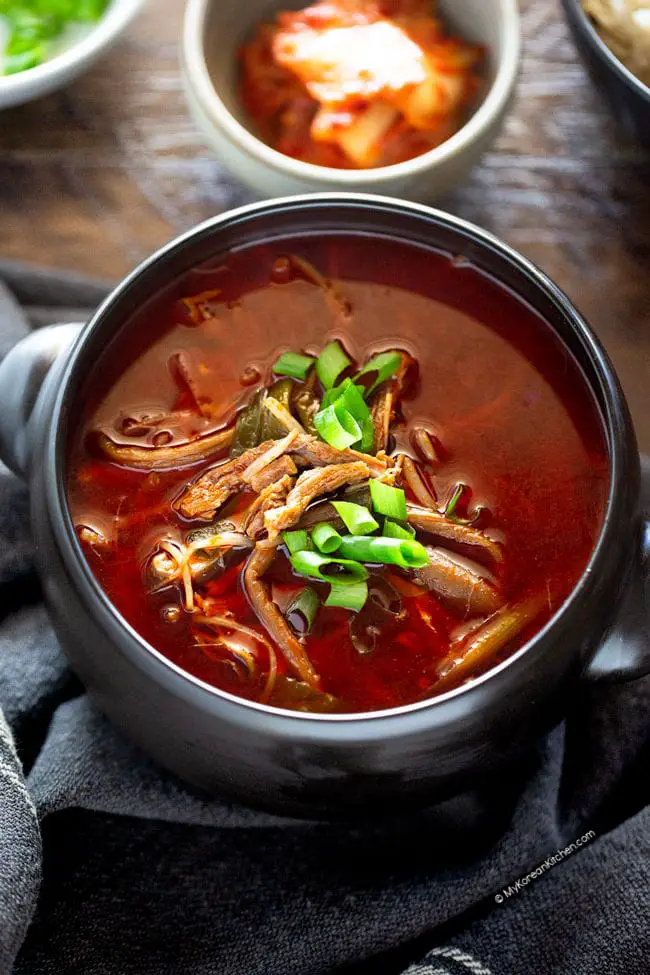
There’s nothing quite like a steaming bowl of yukgaejang on a chilly day. This traditional Korean soup is deeply flavorful with tender beef, earthy vegetables, and a rich, spicy broth that warms you from the inside out. Though it takes time to simmer, the result is well worth the wait—a comforting dish that pairs perfectly with a bowl of rice and your favorite banchan (side dishes).
Ingredients
For the broth
- 350 g beef brisket (about 12 oz) or flank/shank steak
- 10 cups water
- 1 large onion, halved
- 75 g green onions (about 2.5 oz), divided (white and green parts separated, cut into 4–5 cm pieces)
- 1 teaspoon whole black peppercorns
For the soup base
- 1 tablespoon neutral cooking oil (such as rice bran oil)
- 3 tablespoons sesame oil
- 3 tablespoons Korean chili flakes (gochugaru)
- 95 g fresh shiitake mushrooms, thinly sliced
- 100 g soaked fernbrake (gosari), cut into 4–5 cm pieces
- 200 g bean sprouts
- 2 tablespoons Korean chili oil (optional)
- Reserved shredded beef (from broth)
For seasoning
- 2 tablespoons Korean soup soy sauce (gukganjang)
- 1 tablespoon Korean fish sauce (or extra soup soy sauce)
- ½ tablespoon minced garlic
- ½ teaspoon fine sea salt
- ⅛ teaspoon ground black pepper
For garnish
- 10 g green onion, thinly sliced
- Extra sea salt, to taste
Instructions
- Place the beef brisket in a bowl of cold water and let it soak for about 20 minutes, changing the water a few times to draw out the red liquid.
- In a large pot, combine the water, brisket, onion, green onions, and peppercorns. Bring to a boil over high heat, skimming off any foam. Once it boils, cover and reduce heat to medium-low. Simmer for about 45 minutes, leaving you with 7–8 cups of broth.
- Remove the beef and let it cool slightly. Strain the broth, discarding the vegetables, and set aside. Shred the beef into thin strips, trimming away any tough fat.
- Heat a clean pot over medium-low. Add the cooking oil, sesame oil, and green onions. Stir until the onions are softened and fragrant.
- Stir in the chili flakes quickly, allowing them to absorb the oil without burning.
- Pour in the prepared broth, then add the shredded beef and mushrooms. Bring to a gentle boil over medium-high heat.
- Stir in the fernbrake, chili oil (if using), and the seasonings. Cover and simmer for 30 minutes to let the flavors develop.
- Add the bean sprouts and cook for another 10 minutes. Taste and adjust with extra salt if needed.
- Garnish with sliced green onions and serve hot with rice, kimchi, and other Korean side dishes.
Notes
- Patience is key when making yukgaejang—the slow simmering builds layers of flavor. Be careful when stirring in the chili flakes, as they can burn quickly. If you prefer a milder heat, reduce the chili powder slightly.
Nutrition Information:
Yield: 4 Serving Size: 1Amount Per Serving: Calories: 757Total Fat: 51gSaturated Fat: 14gTrans Fat: 1gUnsaturated Fat: 31gCholesterol: 156mgSodium: 1077mgCarbohydrates: 26gFiber: 11gSugar: 5gProtein: 55g
Asianplated.com, occasionally offers nutritional information for recipes contained on this site. This information is provided as a courtesy and is an estimate only. This information comes from online calculators. Although allchickenrecipes.com attempts to provide accurate nutritional information, these figures are only estimates.
A Final Note
Yukgaejang has become one of those recipes that I pull out when I want food that comforts and restores. The slow cooking, the balance of spice and earthiness, the way it pairs so naturally with rice — it feels like a hug in a bowl. If you’re new to Korean cooking, this is a recipe that teaches you patience and rewards you with flavor that feels like it’s been simmering for generations.
Try other Korean recipes:

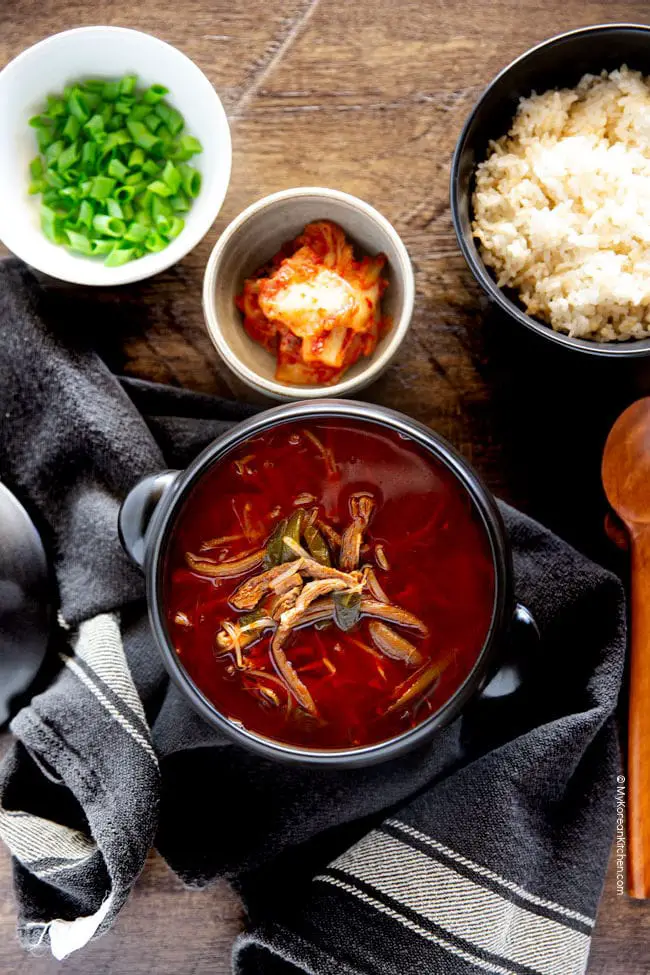 What Makes Yukgaejang Special
What Makes Yukgaejang Special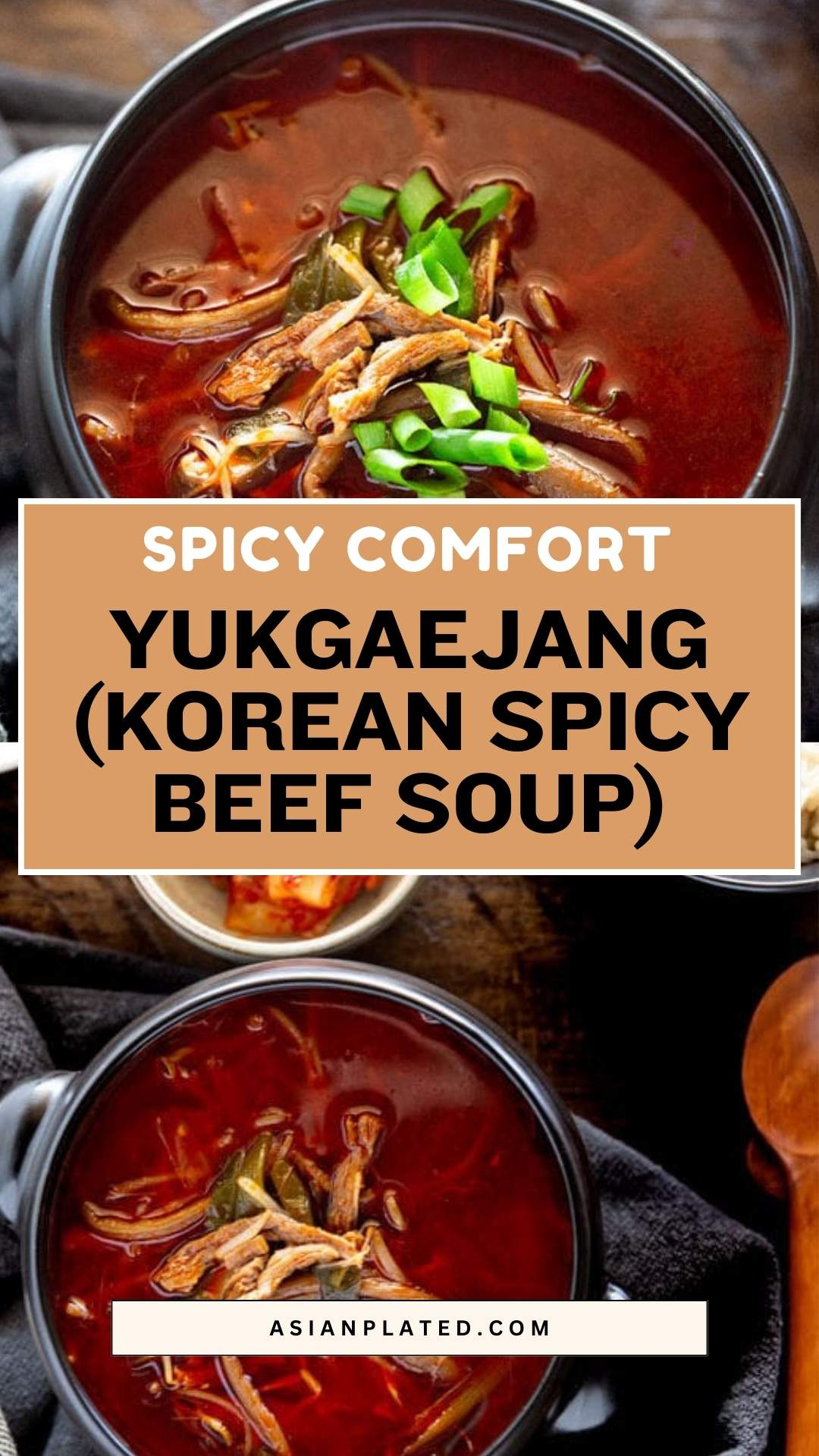 Common Questions I Get
Common Questions I Get

